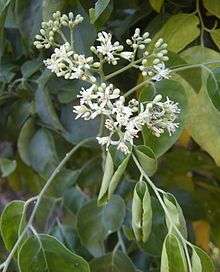Micromelum
| Micromelum | |
|---|---|
 | |
| Micromelum minutum | |
| Scientific classification | |
| Kingdom: | Plantae |
| (unranked): | Angiosperms |
| (unranked): | Eudicots |
| (unranked): | Rosids |
| Order: | Sapindales |
| Family: | Rutaceae |
| Subfamily: | Aurantioideae |
| Tribe: | Clauseneae |
| Subtribe: | Micromelinae |
| Genus: | Micromelum |
| Species | |
|
9-10 | |
Micromelum is a genus of flowering plants in the citrus family, Rutaceae.
There are several subfamilies in the citrus family, with genus Citrus classified in the Aurantioideae. Micromelum belongs to the other tribe in this subfamily, Clauseneae. It is the only genus of the subtribe Micromelinae, which are known technically as the very remote citroid fruit trees.[1]
Micromelum includes about 9[1][2] or 10 species[3][4] of plants distributed in Asia, Australia, and the Pacific Islands.[3]
Description
The genus includes evergreen and deciduous shrubs and trees. The leaves are glandular and aromatic, containing essential oils. They are alternately arranged. They are usually pinnate, divided into up to 23 leaflets, except for M. diversifolium, which sometimes has undivided leaf blades. The leaflet edges are smooth or toothed. There are sometimes glandular stipules. The inflorescence is a large panicle, sometimes flat-topped like a corymb, growing from the leaf axils or at the ends of branches. The flowers have five narrow petals in shades of green, white, or yellow, borne in a hairy, cup-like calyx with five lobes or five separate sepals. The odor of the flowers has been described as "malodorous" and "foetid".[4] There are 10 stamens and 1 to 5 styles. The genus is noted for the unusual curving or twisting of the chambers in the ovary. The fruit is a berry up to a centimeter long. It is yellow, orange, or red, and sometimes fleshy, but it lacks the pulp present in some related fruits, notably citrus. The peel is gland-dotted. Each fruit has 1 to 3 seeds.[1][3][4]
The plants vary in form, with M. hirsutum being a low shrub sometimes less than a meter tall[5] and M. integerrimum being a tree which can exceed 9 meters in height.[1]
Chemistry
M. minutum is used as a traditional medicine in Fiji, and in Malaysia it is used to treat fever and ringworm.[6] M. integerrimum has been used in China to treat dysentery and arthritis.[7]
The chemistry of these plants has been studied, with several known and new coumarins isolated.[6] One such coumarin from M. integerrimum, micromelin, appears to have anticancer properties.[7]
Diversity
Individual species may be hard to distinguish because many are variable in a number of traits. The size of the oil glands on the ovary is a helpful character.[1]
Species and subtaxa include:[2]
- Micromelum diversifolium
- Micromelum diversifolium var. cuneata
- Micromelum ceylanicum
- Micromelum compressum
- Micromelum compressum var. inodorum
- Micromelum falcatum
- Micromelum hirsutum
- Micromelum integerrimum[3]
- Micromelum integerrimum var. integerrimum
- Micromelum integerrimum var. mollissimum
- Micromelum minutum
- Micromelum minutum var. tomentosum
- Micromelum minutum var. curranii
- Micromelum pubescens
- Micromelum scandens
References
- 1 2 3 4 5 Swingle, W. T., rev. P. C. Reece. Chapter 3: The Botany of Citrus and its Wild Relatives. In: The Citrus Industry vol. 1. Webber, H. J. (ed.). Berkeley: University of California Press. 1967.
- 1 2 Citrus Variety Collection. College of Natural and Agricultural Sciences. University of California, Riverside.
- 1 2 3 4 Micromelum. Flora of China.
- 1 2 3 Micromelum. FloraBase. Western Australian Herbarium.
- ↑ Key to the species of Micromelum. Chapter 3: The Botany of Citrus and its Wild Relatives.
- 1 2 Ito, C., et al. (2000). Chemical constituents of Micromelum minutum. Isolation and structural elucidation of new coumarins. Chemical and Pharmaceutical Bulletin - Tokyo 48(3), 334-38.
- 1 2 He, H. P., et al. (2001). Three new coumarins from Micromelum integerrimum. Chinese Chemical Letters 12(7) 603-06.